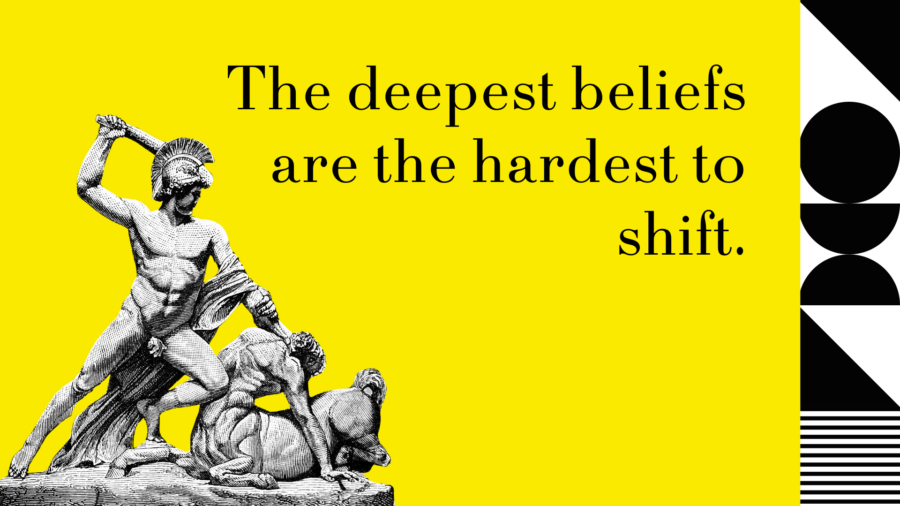Picture a community meeting in a town where the local government has proposed a significant change in the school district’s funding. The auditorium is packed with concerned parents, educators, and students, all charged with emotion about the decision’s potential impacts.
Unfortunately, it doesn’t take long before the meeting devolves into a heated political battle.
One side accuses the other of wanting to dismantle the education system, while the other counters with claims of financial mismanagement and personal self-interest. The atmosphere is tense, with each argument further entrenching the sides into their respective positions.
Then, a local teacher steps up to the microphone. Instead of weighing in on the politics of the situation, they focus on the details of the policy. They talk first about the community’s shared values of quality education and equal opportunities for all students. The teacher outlines how, because current classroom sizes and teacher-student ratios are hindering both of those shared values, they support the proposed shifts in funding.
The tension in the room changes noticeably.
Accusations and insults subside, giving way to more thoughtful and productive dialogue. Instead of questioning motive, morals, and intent, people start to engage in a productive discussion about how the shift in policy would increase individual attention to students.
What happened here?
How did the teacher manage to transform a heated debate between Antagonists into a meaningful discussion? Consciously or not, the teacher recognized that the parents likely held beliefs even deeper than whether to change the funding: beliefs about quality education and equal opportunity that supported the proposed changes.
By shifting the conversation away from the beliefs standing in the way of progress to even stronger beliefs that could serve as starting points for change, the teacher was able to avoid attacking the opponents’ identity and appeal to it instead.
What This Principle Means
Our tendency to believe and behave consistently is both the greatest obstacle and, counterintuitively, the greatest opportunity when it comes to persuasion and change. What’s more, the longer someone believes something, the stronger that belief becomes. The more someone sees that their personal principles deliver on what they want, the more they see them as true.
That’s why attacking someone’s deep-rooted principles and positions rarely results in ready agreement and almost always triggers reactance. More often, you end up damaging the relationships required for sustainable change.
But even though someone’s deep-seated belief may be standing in the way of that change—something psychologists refer to as “cognitive inertia”—it doesn’t mean that all their deep-seated beliefs do. In fact, someone may have equally strong or even stronger beliefs that, if surfaced, would support your change.
When you can bring those principles into play, you can move a conversation from a conflict of identities toward more collaborative problem-solving.
For example, the American Psychological Association reported on a study that focused on approaches that worked to shift the degree of people’s skepticism of a polarizing topic that often produces emotional, knee-jerk reactions: climate change. The researchers found that people who were first asked how credible they found broader, less emotionally charged science (like the role of germs as a primary cause of disease or that gravity explains why objects fall when dropped) were much more likely to find climate science credible (such as rising ocean temperatures or the relationship of global warming to changed weather patterns) than those who were asked only about climate science. Even though the first group didn’t completely change their minds about the existence or source of climate change, they did soften their stance on it. To use the audience categories, they moved from being Antagonists to being Ambivalents.
Substituting alternative, pre-existing beliefs like this helps you avoid triggering short-term emotional reactions in people. It also helps you tap into the beliefs that someone already sees as true because they’ve been internalized through years of experience. This approach turns persuasion into an exercise of exploration and alignment, where you seek out these enduring, shared beliefs and align your message with them.
IN OTHER WORDS…The longer someone has held a belief, the stronger it will be. Search for something even stronger than what’s standing in the way.
When you’re doing this, avoid substituting with primal world beliefs (e.g., “the world is good,” “the world is dangerous,” “everything is interconnected,” etc.) While primal beliefs are possible to shift over time, they probably won’t shift quickly enough for your purposes. Look instead for look for beliefs and principles one step up from those primal beliefs, but below political and identity-based beliefs.
You’re looking for things that, like the climate science study I linked to, most people agree with. Principles of math and science are great for this (“to get to zero, every positive needs a negative,” “a body in motion stays in motion…”), as are commonly accepted proverbs and idioms (“do unto others as you would have them do unto you,” “seeing is believing,” etc.).
Putting It Into Practice
Here’s the essential takeaway: Don’t challenge beliefs, exchange them. When you identify and empower beliefs that are as strong or stronger than those opposing a change, you lay an equally strong foundation for new behaviors or perspectives. You also transform the process of change from a confrontation into a collaboration. Instead of proving someone wrong or dismantling their framework of understanding, you’re connecting and building on deeply held principles you share.
